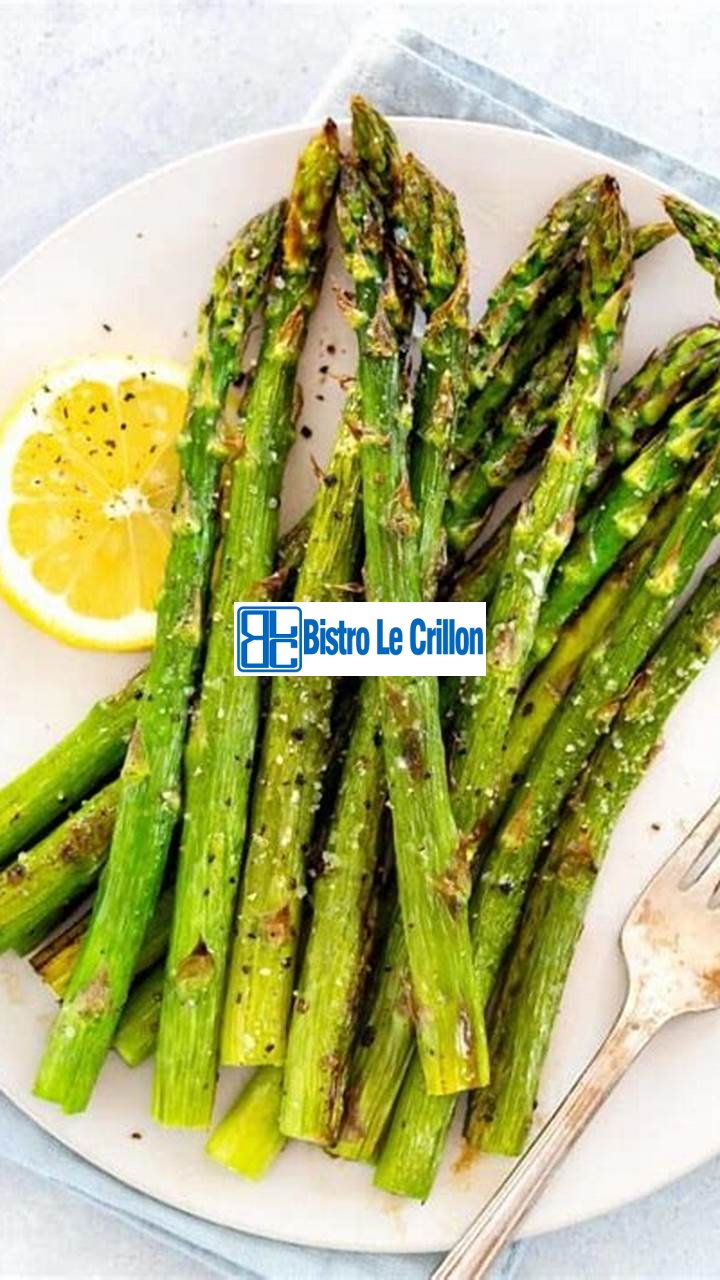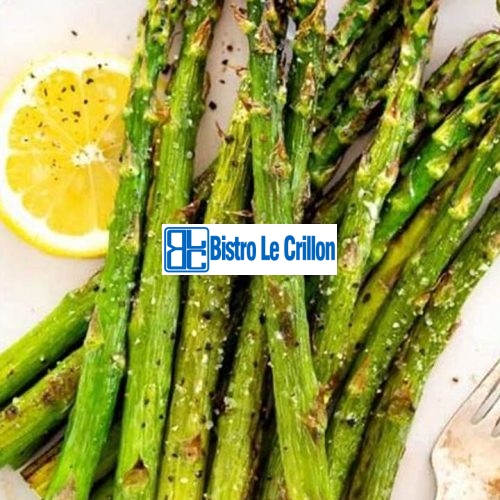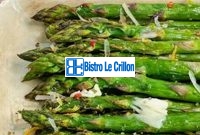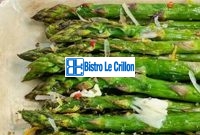Are you ready to master the art of cooking asparagus? ️ Look no further, because in this article, we will guide you through the process of preparing this delicious and nutritious vegetable. Asparagus is not only packed with vitamins and minerals, but it also offers a unique flavor and texture that can elevate any dish. Whether you are a seasoned chef or a cooking novice, we have got you covered with valuable tips, techniques, and mouthwatering recipes. So, let’s dive into the wonderful world of asparagus and unlock your culinary potential!

Understanding Asparagus
Asparagus is a versatile and nutritious vegetable that can elevate any dish with its unique taste and texture. This spear-shaped vegetable is a member of the lily family and is packed with essential nutrients that contribute to a healthy diet. Incorporating asparagus into your meals not only adds flavor but also provides various health benefits. So, let’s delve into the world of asparagus and explore why it is a culinary delight.
What is Asparagus
Asparagus is a perennial herb that is native to Europe and Asia but is now cultivated all over the world. It is known for its long and slender stalks, topped with compact and tightly closed buds, called “spears.” These spears are the edible part of the plant and are harvested before the buds start to open up.
Asparagus comes in different varieties, including green, white, and purple. Green asparagus is the most common type, and it has a slightly sweet and grassy flavor. White asparagus is grown underground, away from sunlight, resulting in its pale color and delicate taste. Purple asparagus, on the other hand, has a sweeter and fruitier flavor compared to its green counterpart.
Asparagus is not only delicious but also incredibly beneficial for your health. It is low in calories and fat while being a rich source of various vitamins and minerals, including vitamin C, vitamin K, vitamin E, folate, and potassium. Additionally, it is a good source of dietary fiber, making it a valuable addition to a balanced diet.
Nutritional Value of Asparagus
Asparagus is a nutritional powerhouse, providing a wide array of essential vitamins, minerals, and antioxidants. Here is a breakdown of its key nutritional components:
- Vitamin C: Asparagus is an excellent source of vitamin C, an essential nutrient that boosts immune function, aids in collagen production, and acts as a powerful antioxidant to protect against cellular damage.
- Vitamin K: This vegetable is also rich in vitamin K, which plays a vital role in bone health, blood clotting, and heart health.
- Folate: Asparagus is packed with folate, a B-vitamin that supports cell production and helps prevent specific birth defects.
- Potassium: Asparagus contains potassium, an electrolyte that helps maintain fluid balance, nerve function, and muscle contractions.
In addition to these nutrients, asparagus contains various antioxidants like flavonoids and polyphenols, which help protect the body against harmful free radicals and reduce the risk of chronic diseases, including heart disease and certain types of cancer.
Selecting and Storing Asparagus
When buying asparagus, it is important to choose fresh and high-quality spears to ensure maximum flavor and nutritional value. Here are some tips for selecting and storing asparagus:
- Look for firm stalks: Choose asparagus spears that are firm and crisp, without any signs of wilting or bending.
- Bright green or purple color: The color of asparagus should be vibrant and uniform. Avoid any spears with discoloration or yellowing.
- Avoid dry or slimy tips: Check the tips of the asparagus spears and make sure they are not dried out or slimy.
- Store properly: To keep asparagus fresh, trim about half an inch from the bottom of the stalks and place them upright in a glass of water. Alternatively, wrap the ends in a damp paper towel and store them in a resealable bag in the refrigerator. Asparagus is best consumed within three to four days of purchase.
Now that you have a better understanding of asparagus and its nutritional value, you can confidently incorporate this delicious vegetable into your meals. Whether you grill, roast, steam, or sauté it, asparagus will bring a burst of flavor and nutritious goodness to your plate. So, get creative and enjoy the art of cooking asparagus!
Preparing Asparagus
When it comes to cooking asparagus, proper preparation is key to achieving optimal taste and texture. By following the essential steps outlined below, you’ll be able to master the art of cooking asparagus and prepare it in a way that brings out its natural flavors.
Washing and Trimming Asparagus
Start by washing the asparagus spears thoroughly under cold running water. This helps remove any dirt or grit that may be present. To ensure that the asparagus is properly cleaned, gently rub each spear with your hands.
Once the asparagus is clean, it’s time to trim the tough ends. Hold each spear with one hand and bend it gently until it snaps. The point where the asparagus naturally breaks is where the tough, woody part ends. Discard the snapped ends and keep the tender parts for cooking.
Note: Taking this extra step of snapping the asparagus helps ensure that you’re left with only the most tender and flavorful parts to cook.
Peeling Asparagus (optional)
While peeling asparagus is optional, it can help remove any stringy fibers that may be present on the outer layer. To peel the asparagus, use a vegetable peeler and gently run it along the outer layer from the base to the tip of each spear. This step is particularly recommended for thicker asparagus spears.
Note: Peeling the asparagus can result in a smoother texture and more enjoyable eating experience.
Steaming Asparagus
Steaming asparagus is a popular cooking method that helps retain its vibrant color and crisp texture. To steam asparagus, you’ll need a steamer basket and a pot with water.
- First, place the steamer basket in the pot and add enough water so that it doesn’t touch the bottom of the basket.
- Bring the water to a boil over medium heat.
- Once the water is boiling, carefully place the prepared asparagus spears in the steamer basket.
- Cover the pot with a lid and steam the asparagus for about 3-5 minutes, or until the spears are tender but still slightly crisp.
- Once cooked, remove the asparagus from the steamer and transfer it to a serving dish.
Note: Steaming asparagus helps preserve its nutrients and results in a deliciously tender yet crunchy texture.
By following these essential steps – washing and trimming, optionally peeling, and steaming – you can elevate your asparagus cooking game and enjoy this versatile vegetable in the most delicious way possible. Whether you’re creating a side dish or incorporating it into main courses, mastering the art of cooking asparagus will surely impress your taste buds and those of your family and friends. Happy cooking!
Various Cooking Methods for Asparagus
When it comes to preparing asparagus, there are several cooking methods you can utilize to bring out the best flavors and textures of this versatile vegetable. Whether you prefer a crispy roast, a savory sauté, or a smoky grill, each method offers a unique way to elevate the taste of asparagus to new heights.
Roasting Asparagus
Roasting asparagus is a popular cooking method that brings out a rich and caramelized flavor in this springtime vegetable. To achieve perfectly roasted asparagus, preheat your oven to 425°F (220°C). Trim the ends of the asparagus spears and lay them in a single layer on a baking sheet lined with parchment paper. Drizzle olive oil over the asparagus, sprinkle with salt and pepper, and toss gently to ensure an even coating. Roast for 10-15 minutes, or until the asparagus becomes tender and slightly browned. The heat of the oven intensifies the natural sweetness of the asparagus, resulting in a delightful taste and a slightly crispy texture.
Sautéing Asparagus
Sautéing asparagus is a quick and easy method that allows you to enjoy a tender and flavorful vegetable in a matter of minutes. Start by heating a tablespoon of olive oil or butter in a skillet over medium-high heat. Add the trimmed asparagus spears to the skillet and season with salt and pepper. Stir-fry the asparagus for 5-7 minutes, or until they are bright green and slightly tender. The key to sautéing asparagus successfully is to maintain high heat and avoid overcooking, as this can result in mushy asparagus. The sautéing process locks in the natural flavors of the asparagus while keeping a pleasant crunch.
Grilling Asparagus
Grilling asparagus adds a smoky and charred flavor that takes this vegetable to the next level. Before grilling, wash and trim the asparagus spears. Preheat your grill to medium-high heat and lightly oil the grates to prevent sticking. Place the asparagus spears horizontally across the grates, making sure they don’t fall through. Grill for 3-4 minutes per side, rotating the spears halfway through, until they develop grill marks and become tender but firm. The heat from the grill enhances the natural sweetness of the asparagus while imparting a delightful smoky taste. Grilled asparagus is a perfect addition to summer barbecues or a delicious side for grilled meats.
Embrace the different cooking methods for asparagus and experiment with various flavors and seasonings to find your favorite way of preparing this fantastic vegetable. Whether you prefer the rich flavors of roasted asparagus, the quick and easy sautéed version, or the smoky taste of grilled spears, the possibilities are endless. So go ahead, master the art of cooking asparagus, and enjoy this nutritious and delicious vegetable in all its glory!
Serving and Pairing Asparagus
When it comes to cooking asparagus, it’s not just about knowing how to prepare this nutritious vegetable. You also need to have a good understanding of how to serve and pair it to ensure a delicious meal. In this section, we will explore fantastic ideas for serving asparagus as a side dish or incorporating it into various recipes.
Asparagus in Salads
Adding asparagus to salads can be a great way to elevate their flavors and add a touch of freshness. One idea is to create a spring-inspired salad with a mix of asparagus, cherry tomatoes, feta cheese, and a tangy lemon vinaigrette. The crispness of the asparagus and the brightness of the lemon will create a refreshing combination that is perfect for warmer days.
- Pro Tip: Blanche the asparagus briefly before adding it to the salad. This will help retain its vibrant green color and slightly soften the texture.
Asparagus in Pasta Dishes
Asparagus can lend a unique flavor and texture to pasta dishes, making them more exciting and satisfying. For a quick and easy option, toss cooked asparagus with cooked pasta, olive oil, garlic, and parmesan cheese. This simple combination creates a delightful dish that showcases the natural sweetness of asparagus.
- Pro Tip: Cut the asparagus into bite-sized pieces and sauté them before adding to the pasta. This helps to release their flavors and brings out their natural sweetness.
Asparagus with Protein
Pairing asparagus with protein not only adds nutritional value but also creates a well-balanced and satisfying meal. Grilled asparagus pairs exceptionally well with chicken or fish. The smoky flavor from the grill and the natural sweetness of asparagus create a harmonious combination of tastes.
- Pro Tip: Marinate the asparagus in a mixture of olive oil, garlic, lemon juice, and your favorite herbs before grilling. This will infuse the asparagus with additional flavors and enhance its taste.
All in all, asparagus is a versatile vegetable that can be enjoyed in various ways. Whether you choose to incorporate it into salads, pasta dishes, or pair it with protein, the key is to let its unique flavors shine through. So, get creative in the kitchen and master the art of cooking asparagus to impress your taste buds and your guests!
Troubleshooting and FAQs
When it comes to cooking asparagus, there may be some common issues that arise and questions that need to be answered. In this section, we will address a few of these concerns to help you master the art of cooking asparagus.
Overcooked or Mushy Asparagus
If you’ve ever cooked asparagus and ended up with a mushy or overcooked result, you’re not alone. Overcooking asparagus can lead to a loss of flavor and texture. To avoid this, follow these tips:
- Start by selecting fresh and tender asparagus spears. Look for bright green color and firm stems.
- Trim off the tough ends of the asparagus spears. The best way to do this is by gently bending the asparagus until it snaps. Discard the woody ends.
- Steam or blanch the asparagus instead of boiling it. This helps retain its vibrant color and crispness.
- Cook the asparagus for a shorter time. Depending on the thickness of the spears, it usually takes around 3 to 5 minutes to cook. You can check for doneness by poking the asparagus with a fork. It should be tender yet still have a slight bite to it.
By following these steps, you can ensure that your asparagus stays perfectly cooked and retains its natural flavor and texture.
Bitter Asparagus
Bitterness in asparagus can be a common problem and can greatly affect the overall taste of your dish. To avoid this issue, try the following tips:
- Again, start with fresh and high-quality asparagus. Look for bright green color and firm texture.
- Remove any tough or woody ends by gently bending the asparagus until it naturally breaks.
- Blanch the asparagus in boiling salted water for a short amount of time, around 2 to 3 minutes, to help reduce the bitterness.
- If you still find the asparagus to be slightly bitter after cooking, try adding a squeeze of lemon juice or a drizzle of balsamic glaze. These acidic additions can help balance out the bitterness.
By following these steps, you can minimize the bitterness and enhance the overall taste of your asparagus dishes.
Can I Eat Asparagus Raw?
While asparagus is typically cooked before consuming, you may wonder if it can be eaten raw. The answer is yes! Raw asparagus can be enjoyed in various ways:
- Shave or thinly slice the asparagus and add it to salads for a fresh and crunchy texture.
- Marinate raw asparagus in lemon juice, olive oil, salt, and pepper for a simple and flavorful side dish.
- Use raw asparagus as a crisp and nutritious dipping vegetable for hummus or other dips.
Raw asparagus provides a different taste and texture compared to its cooked counterpart. It can be a great addition to your culinary repertoire, offering unique flavors and versatility.
Note: It’s worth noting that some people may find raw asparagus slightly fibrous and prefer it cooked. It ultimately comes down to personal preference.
Now armed with the knowledge to troubleshoot common asparagus cooking issues and answer frequently asked questions, you can confidently master the art of cooking asparagus. With practice, you’ll be able to prepare this versatile and nutritious vegetable in a variety of delicious ways.
Frequently Asked Questions
Here are some frequently asked questions about cooking asparagus:
| No. | Questions | Answers |
|---|---|---|
| 1. | How long should I cook asparagus? | Asparagus typically takes around 10-15 minutes to cook. You can boil, steam, roast, or grill it to achieve different textures and flavors. |
| 2. | Should I peel asparagus before cooking? | Generally, it is not necessary to peel asparagus before cooking. The skin is thin and tender. However, if the spears are thick and woody, you may want to peel the bottom portion for a more enjoyable texture. |
| 3. | How do I know if asparagus is fresh? | Fresh asparagus should have firm and crisp stalks with tightly closed tips. Additionally, it should have a vibrant green color and a minimal odor. Avoid any wilted or slimy asparagus. |
| 4. | Can I eat the entire asparagus spear? | Yes, you can eat the entire asparagus spear. However, the bottom portion of the stalk may be tough and fibrous. It is recommended to snap off the woody ends or peel them if they are thicker. |
| 5. | What are some popular seasoning options for asparagus? | Some popular seasoning options for asparagus include garlic, lemon juice, olive oil, salt, and pepper. You can also experiment with herbs like thyme, rosemary, or Parmesan cheese for added flavor. |
| 6. | Is asparagus a healthy vegetable? | Yes, asparagus is a healthy vegetable. It is low in calories and rich in nutrients such as folate, vitamin K, vitamin C, and fiber. It also contains antioxidants and may have various health benefits. |
Closing Thoughts
Thank you for reading this article on how to cook asparagus! We hope you found the information helpful and inspiring for your future cooking endeavors. Asparagus is a versatile vegetable that can be prepared in various ways, allowing you to experiment and create delicious dishes. Whether you prefer it roasted, grilled, or sautéed, asparagus can be a delightful addition to your meals. Remember to visit again later for more exciting recipes and cooking tips. Enjoy your cooking adventures and savor the flavors of fresh asparagus!

How to Cook Asparagus
Ingredients
- 1 bunch of asparagus spears
- 1 tablespoon olive oil
- 1 clove garlic minced
- Salt and pepper to taste
Instructions
- Preheat the oven to 400°F (200°C).
- Wash the asparagus spears and trim off the woody ends by snapping them off where they naturally break.
- Place the asparagus in a baking dish and drizzle with olive oil. Add minced garlic, salt, and pepper. Toss to coat evenly.
- Place the baking dish in the preheated oven and roast for 10-15 minutes, or until the asparagus is tender and slightly caramelized.
- Remove the roasted asparagus from the oven and serve hot. Enjoy as a side dish or incorporate it into your favorite recipes.






